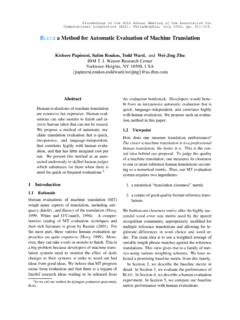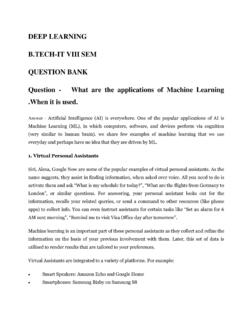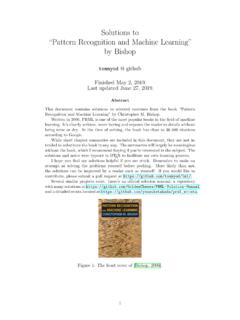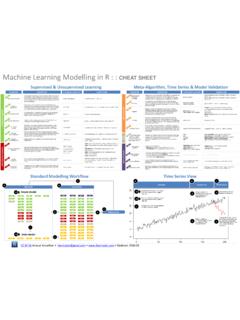Transcription of A arXiv:1412.6572v3 [stat.ML] 20 Mar 2015
1 Published as a conference paper at ICLR 2015 EXPLAINING ANDHARNESSINGADVERSARIALEXAMPLESIan J. Goodfellow, Jonathon Shlens & Christian SzegedyGoogle Inc., Mountain View, machine learning models, including neural networks, consistently mis-classifyadversarial examples inputs formed by applying small but intentionallyworst-case perturbations to examples from the dataset, such that the perturbed in-put results in the model outputting an incorrect answer with high confidence. Earlyattempts at explaining this phenomenon focused on nonlinearity and argue instead that the primary cause of neural networks vulnerability to ad-versarial perturbation is their linear nature.
2 This explanation is supported by newquantitative results while giving the first explanation of the most intriguing factabout them: their generalization across architectures and training sets. Moreover,this view yields a simple and fast method of generating adversarial examples. Us-ing this approach to provide examples for adversarial training, we reduce the testset error of a maxout network on the MNIST et al. (2014b) made an intriguing discovery: several machine learning models, includingstate-of-the-art neural networks, are vulnerable toadversarial examples. That is, these machinelearning models misclassify examples that are only slightly different from correctly classified exam-ples drawn from the data distribution.
3 In many cases, a wide variety of models with different archi-tectures trained on different subsets of the training data misclassify the same adversarial suggests that adversarial examples expose fundamental blind spots in our training cause of these adversarial examples was a mystery, and speculative explanations have suggestedit is due to extreme nonlinearity of deep neural networks, perhaps combined with insufficient modelaveraging and insufficient regularization of the purely supervised learning problem. We show thatthese speculative hypotheses are unnecessary. Linear behavior in high-dimensional spaces is suf-ficient to cause adversarial examples.
4 This view enables us to design a fast method of generatingadversarial examples that makes adversarial training practical. We show that adversarial training canprovide an additional regularization benefit beyond that provided by using dropout (Srivastava et al.,2014) alone. Generic regularization strategies such as dropout, pretraining, and model averaging donot confer a significant reduction in a model s vulnerability to adversarial examples, but changingto nonlinear model families such as RBF networks can do explanation suggests a fundamental tension between designing models that are easy to train dueto their linearity and designing models that use nonlinear effects to resist adversarial the long run, it may be possible to escape this tradeoff by designing more powerful optimizationmethods that can succesfully train more nonlinear WORKS zegedy et al.
5 (2014b) demonstrated a variety of intriguing properties of neural networks and relatedmodels. Those most relevant to this paper include: Box-constrained L-BFGS can reliably find adversarial examples. On some datasets, such as ImageNet (Deng et al., 2009), the adversarial examples were soclose to the original examples that the differences were indistinguishable to the human eye. The same adversarial example is often misclassified by a variety of classifiers with differentarchitectures or trained on different subsets of the training [ ] 20 Mar 2015 Published as a conference paper at ICLR 2015 Shallow softmax regression models are also vulnerable to adversarial examples.
6 Training on adversarial examples can regularize the model however, this was not practicalat the time due to the need for expensive constrained optimization in the inner results suggest that classifiers based on modern machine learning techniques, even thosethat obtain excellent performance on the test set, are not learning the true underlying concepts thatdetermine the correct output label. Instead, these algorithms have built a Potemkin village that workswell on naturally occuring data, but is exposed as a fake when one visits points in space that do nothave high probability in the data distribution. This is particularly disappointing because a popularapproach in computer vision is to use convolutional network features as a space where Euclideandistance approximates perceptual distance.
7 This resemblance is clearly flawed if images that have animmeasurably small perceptual distance correspond to completely different classes in the network results have often been interpreted as being a flaw in deep networks in particular, even thoughlinear classifiers have the same problem. We regard the knowledge of this flaw as an opportunity tofix it. Indeed, Gu & Rigazio (2014) and Chalupka et al. (2014) have already begun the first stepstoward designing models that resist adversarial perturbation, though no model has yet succesfullydone so while maintaining state of the art accuracy on clean LINEAR EXPLANATION OF ADVERSARIAL EXAMPLESWe start with explaining the existence of adversarial examples for linear many problems, the precision of an individual input feature is limited.
8 For example , digitalimages often use only 8 bits per pixel so they discard all information below1/255of the dynamicrange. Because the precision of the features is limited, it is not rational for the classifier to responddifferently to an inputxthan to an adversarial input x=x+ if every element of the perturbation is smaller than the precision of the features. Formally, for problems with well-separated classes,we expect the classifier to assign the same class toxand xso long as|| || < , where is smallenough to be discarded by the sensor or data storage apparatus associated with our the dot product between a weight vectorwand an adversarial example x:w> x=w>x+w>.
9 The adversarial perturbation causes the activation to grow byw> .We can maximize this increasesubject to the max norm constraint on by assigning =sign(w). Ifwhasndimensions and theaverage magnitude of an element of the weight vector ism, then the activation will grow by || || does not grow with the dimensionality of the problem but the change in activationcaused by perturbation by can grow linearly withn, then for high dimensional problems, we canmake many infinitesimal changes to the input that add up to one large change to the output. Wecan think of this as a sort of accidental steganography, where a linear model is forced to attendexclusively to the signal that aligns most closely with its weights, even if multiple signals are presentand other signals have much greater explanation shows that a simple linear model can have adversarial examples if its input has suf-ficient dimensionality.
10 Previous explanations for adversarial examples invoked hypothesized prop-erties of neural networks, such as their supposed highly non-linear nature. Our hypothesis basedon linearity is simpler, and can also explain why softmax regression is vulnerable to PERTURBATION OF NON-LINEAR MODELSThe linear view of adversarial examples suggests a fast way of generating them. We hypothesizethat neural networks are too linear to resist linear adversarial perturbation. LSTMs (Hochreiter &Schmidhuber, 1997), ReLUs (Jarrett et al., 2009; Glorot et al., 2011), and maxout networks (Good-fellow et al., 2013c) are all intentionally designed to behave in very linear ways, so that they areeasier to optimize.

![arXiv:0706.3639v1 [cs.AI] 25 Jun 2007](/cache/preview/4/1/3/9/3/1/4/b/thumb-4139314b93ef86b7b4c2d05ebcc88e46.jpg)

![arXiv:1301.3781v3 [cs.CL] 7 Sep 2013](/cache/preview/4/d/5/0/4/3/4/0/thumb-4d504340120163c0bdf3f4678d8d217f.jpg)
![@google.com arXiv:1609.03499v2 [cs.SD] 19 Sep 2016](/cache/preview/c/3/4/9/4/6/9/b/thumb-c349469b499107d21e221f2ac908f8b2.jpg)











